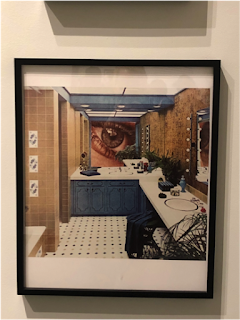The
notion of constructing an identity is based on a multitude of factors. Judith
Howard explains this phenomenon in her essay, “Social Psychology of
Identities.” “In current times…the concept of identity carries the full
weight of the need for a sense of who one is, together with an often
overwhelming pace of change in surrounding social contexts—changes in the
groups and networks in which people and their identities are embedded and in
the societal structures and practices in which those networks are themselves
embedded.” (367). Her
analysis of the conception of identity coincides with some pieces of art from
the exhibit at the Montclair Museum:
The
first work of art I chose from the exhibit is a photograph of a drag queen. In
the Guardian article “RuPaul: ‘Drag is a big f-you to male-dominated culture’”,
RuPaul discusses how those that participate in the art of drag are rejecting
this preconceived notion of what identity should be: “It’s a totem, a constant
touchstone to say, ‘Don’t take any of this shit seriously.’ It’s a big f-you.
So the idea of sticking to one identity – it’s like I don’t care, I’m a
shapeshifter, I’m going to fly around and use all the colours, and
not brand myself with just one colour” (Aitkenhead). Drag queens, like Misty,
use nonconformity as a sense of their identity.
 |
IDENTITY AND NONCONFORMITY
Nan Goldin
Misty and Joey at Hornstrasse, Berlin, 1992
|
I chose another photograph that illustrates nonconformity as a sense of identity. “Jo’s tattooed arms and short hair, aspects of a counter-culture lifestyle as a professional piercer and acupuncturist, are subsumed with her almost regal pose and thoughtful demeanor.” The fact that Jo is not stereotypically female yet posed in a thoughtful way shows that identity is not concretely based on societal norms. Identity is made up of many aspects. This photograph breaks the stereotypes surrounding Jo’s identity.
 |
ETHNIC AND CULTURAL IDENTITY
Dawoud Bey
Smokey, 2001
|
“Kruger’s
work questions the viewer about feminism, classicism, consumerism, desire, and
individual autonomy, contrasting with the black-and-white images she culls from
mainstream magazines that monetize these very ideas.” These questions that
Kruger’s work asks have can an effect on one’s identity because of how society
pushes them. Therefore, it’s important to have a discussion about these topics
that are deeply imbedded in society and culture. “The act of seeing is one
imbued with power, and Kruger’s ultimate goal is to intercept the stereotype,
code, or convention by which power is arbitrarily imposed.” In a patriarchal
society, the male gaze is a powerful component and Kruger’s photo challenges
this.
 |
ETHNIC AND CULTURAL IDENTITY
Barbara Kruger
Untitled (Seeing through you), 2004-05
|
The
last photo I chose was about space because of the importance it has on
identity. The photograph shows a bathroom and an eye where the mirror should
be. “She emphasizes the particular scrutiny women endure with the superimposed
image of an eye, or “the internalized eye of CULTURE looking at every woman,
even in the privacy of her own ‘sacred space,’ the American bathroom.”” Howard
discusses the importance of “place identities” and how it affects a person’s
identity (382). The way society sees a woman can affect them even in their most
private places, which can have a negative affect on their identity because they
are always trying to achieve the identity that society wants.
 |
IDENTITY AND PERSONAL SPACES
Martha Rosler
Vanity Eye (Bathroom Surveillance) from Beauty Knows No Pain, or Body Beautiful, 1966-72
|

No comments:
Post a Comment